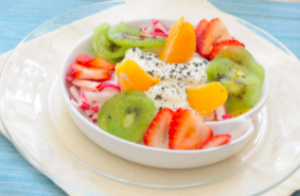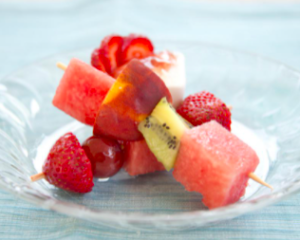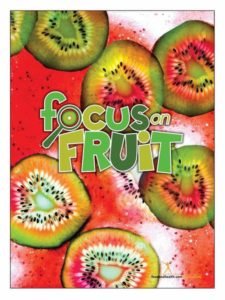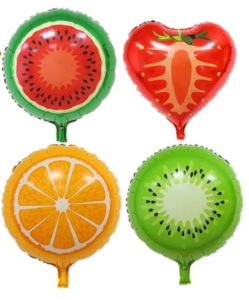Eating in Color: Green
We're back with more Eating in Color! So far we've covered red, orange, and yellow fruits and vegetables. Check them out at the links below:
And now it's time to start the next chapter: green! Green fruits and vegetables are generally high in fiber, potassium, vitamin A, vitamin C, and even folate! There are lots to choose from, so to start, let's take a closer look at the kiwi. This is one of my favorite green fruits, and I hope your clients will love it as well! Kiwis are extremely high in vitamin C, with 64 milligrams (mg) in a single fruit. That's more than you'll find in an orange, a strawberry, or even a lemon! Kiwis also have lots of fiber, folate, potassium (5% of your daily value in just one kiwi), and even vitamin E. Vitamin E is a fat-soluble antioxidant that fights free radicals and strengthens the immune system. There's also a decent amount (34mg in 100g of kiwi) of calcium in there!According to the study The Nutritional and Health Attributes of Kiwifruit: A Review by David P. Richardson, Juliet Ansell, and Lynley N. Drummond, "Kiwifruit are a nutrient-dense fruit and extensive research over the last decade on the health benefits of kiwifruit has linked their regular consumption to improvements not only in nutritional status, but also benefits to digestive, immune, and metabolic health."
Kiwis are extremely high in vitamin C, with 64 milligrams (mg) in a single fruit. That's more than you'll find in an orange, a strawberry, or even a lemon! Kiwis also have lots of fiber, folate, potassium (5% of your daily value in just one kiwi), and even vitamin E. Vitamin E is a fat-soluble antioxidant that fights free radicals and strengthens the immune system. There's also a decent amount (34mg in 100g of kiwi) of calcium in there!According to the study The Nutritional and Health Attributes of Kiwifruit: A Review by David P. Richardson, Juliet Ansell, and Lynley N. Drummond, "Kiwifruit are a nutrient-dense fruit and extensive research over the last decade on the health benefits of kiwifruit has linked their regular consumption to improvements not only in nutritional status, but also benefits to digestive, immune, and metabolic health." When you shop for kiwis, skip any with cuts or bruises. Press on the fruit gently. If it is firm but yielding, it's ready to eat (skip the mushy ones). If its hard, your kiwi is ready to buy but may need a few days to ripen.To help your kiwis ripen, store them at room temperature in a brown paper bag, away from direct sunlight. Once your kiwis are ripe, you can store them in the fridge.
When you shop for kiwis, skip any with cuts or bruises. Press on the fruit gently. If it is firm but yielding, it's ready to eat (skip the mushy ones). If its hard, your kiwi is ready to buy but may need a few days to ripen.To help your kiwis ripen, store them at room temperature in a brown paper bag, away from direct sunlight. Once your kiwis are ripe, you can store them in the fridge. We love kiwis, as you can tell from our recipe archive. Often the best way to eat them is to simply peel off the brown skin and cut the kiwi into slices. However, if you'd like to do more with your kiwi fruits, here are a few of our favorite recipes:
We love kiwis, as you can tell from our recipe archive. Often the best way to eat them is to simply peel off the brown skin and cut the kiwi into slices. However, if you'd like to do more with your kiwi fruits, here are a few of our favorite recipes:
- Hi-Phy Fruit Salad
- Fruit Kebabs with Yogurt Dip
- Kiwi Berry Salad
- Kiwi Agua Fresca
- Watermelon Citrus Cooler
As always, there are lots of other green fruits to try. If your clients aren't into kiwis, consider...
- Green grapes
- Limes
- Honeydew
- Kiwi berries
- Green apples/pears
Remember, there are lots of helpful resources in the Nutrition Education Store!


